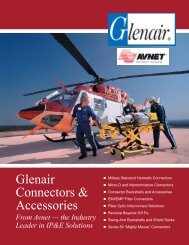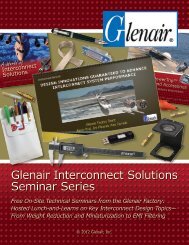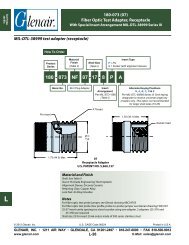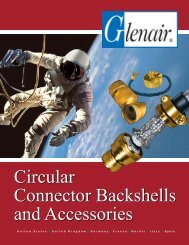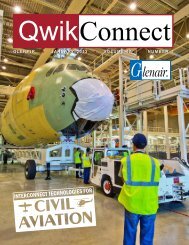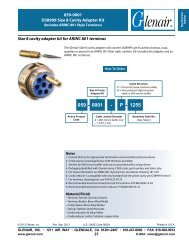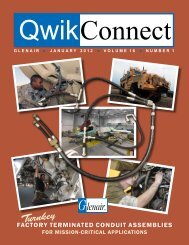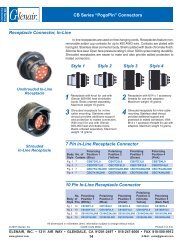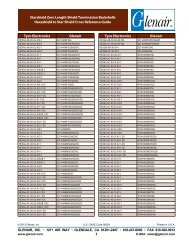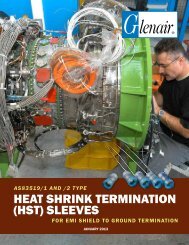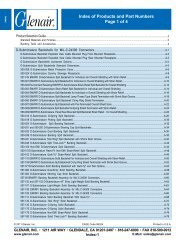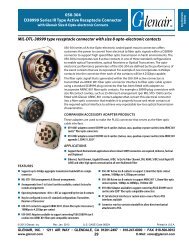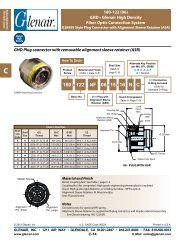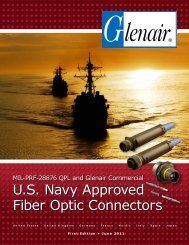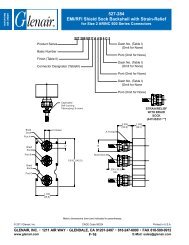April 2007 - Glenair, Inc.
April 2007 - Glenair, Inc.
April 2007 - Glenair, Inc.
You also want an ePaper? Increase the reach of your titles
YUMPU automatically turns print PDFs into web optimized ePapers that Google loves.
TestReport<br />
2.7.4 Exceptions<br />
The backshells were visually examined per the final examination requirements in section 4.2,<br />
D022Z001-01 and section 7.0, Z43S0-WAB. 5X magnification maximum was allowed during<br />
the final examination.<br />
The following visual observations were noted: Test article #01, which was soaked in BMS 3-<br />
11, type IV, class 1 hydraulic fluid, fire resistant, was missing the part number and date code<br />
that was stamped on each of the backshells.<br />
On test article #04, which was soaked in heat transfer fluid, Dow Frost 60, the backshell from<br />
the receptacle connector side appears to have a crack around the tightening portion. It was<br />
determined that the backshell had cracked before testing. Therefore a new backshell was<br />
used to retest the Dow Frost 60 fluid. The retest passed all requirements.<br />
2.8 Hydrolytic Stability (composite only)<br />
2.8.1 Requirement<br />
When tested, there shall be no increase in weight greater than 5 percent. Backshells shall<br />
meet the coupling thread strength requirements.<br />
2.8.2 Test Method<br />
Composite backshells shall be tested for water absorption in accordance with ASTM D 570,<br />
paragraph 7.4, long term immersion.<br />
2.8.3 Results<br />
All samples met coupling strength requirements. The average two-week weight gain for all<br />
samples was less than 1%<br />
2.9 Indirect Lightning Strike<br />
2.9.1 Requirement<br />
The objective of this test is to ensure that the composite backshell does not show any<br />
evidence of damage that would prevent proper functioning of the connector assembly.<br />
Backshells shall be tested for the ability to conduct indirect lightning currents through the<br />
metallic finish without damaging the base materials or causing the metallic finish to blister or<br />
char. The parts should be visually inspected for any damage to the metallic plating. There shall<br />
be no evidence of blistering or charring. The backshell shall also be inspected to ensure that<br />
the thermoplastic material was not damaged by the thermal energy developed during testing.<br />
2.9.2 Test Method<br />
The backshell shall be tested as specified per EIA–364–75, Waveform 5B for the ability to<br />
conduct lightning currents except as follows:<br />
Time T1 shall be 50 μsec +20 percent<br />
Time T2 shall be 500 μsec +20 percent<br />
Test level shall be 6,000 Amps. Ten positive polarity transients shall be applied followed by ten<br />
negative polarity transients. The time between individual transients is not critical. All transients<br />
shall be applied at the applicable peak amplitude level.<br />
24 QwikConnect <strong>April</strong> <strong>2007</strong>



